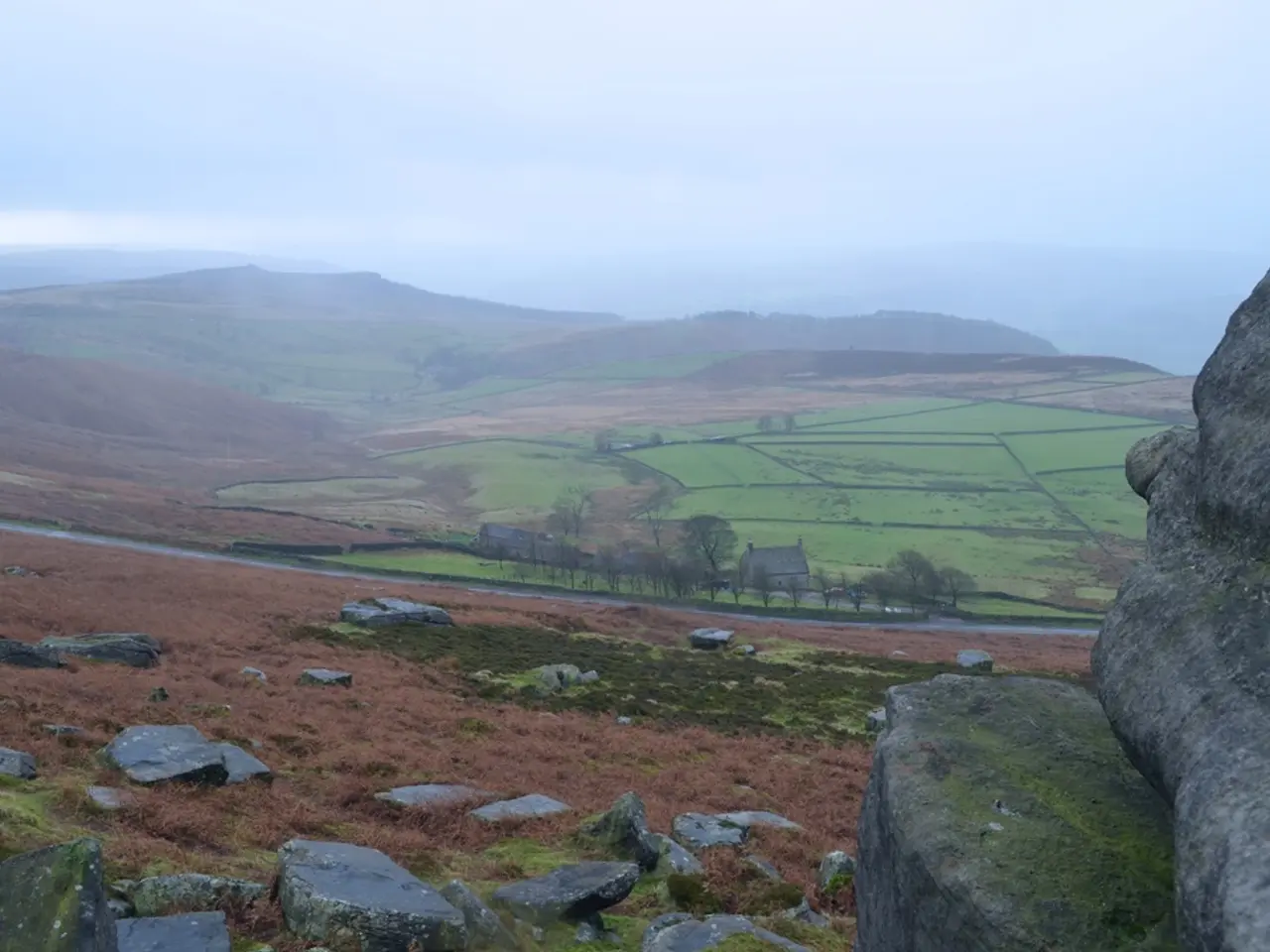Tourist Handbook for Acadia National Park: Strategies to Witness Scenic Spots and Escape the Hustle
Stop the fight at the Jordan Pond House: this picturesque tourist spot in Acadia National Park has turned hostile, with anger-fueled drivers swiping parking spots and hurling foul language at each other, all for a taste of the joint's iconic pastry, the popover. The chaos doesn't stop there – the Park Loop Road is experiencing its own backlash, with shuttle bus drivers being overwhelmed by visitors, leading to lengthy wait times.
Welcome to the allure and chaos of Acadia National Park, nestled in the heart of central Mount Desert Island. The national park also encompasses Schoodic Peninsula, Isle au Haut, and other outer islands. However, there are only two formalized park entrances: one by Sand Beach and another near Cadillac Mountain, both on Mount Desert Island. Since 1990, rangers have relied on data from these two entrances to make an educated guess about the park's total number of visitors.
The number skyrocketed in the hot summer of 2022, marking Acadia's popularity. Unsurprisingly, millions of families sought a sunny escape after the COVID-19 pandemic during the summer and early fall. Coined as "revenge travel" by social media, this phenomenon refers to making up for missed travel due to the Coronavirus pandemic. The result? Acadia's second-highest visitation rate on record: 3,970,201.
The influx of "revenge vacationers" came with a troubling side effect. In 2020, the Island Explorer, the local shuttle bus system, took a short break due to COVID-19. But by the time service resumed in 2022, visitors had already grown accustomed to their cars, opting for private transportation over public options. There were approximately 54,000 more cars on the island in 2022 than in 2019, and even 11,000 more in August alone. In an ironic twist of events, these visitors came to nature to enjoy its beauty but ultimately contributed to its destruction.
To tackle the challenges posed by the increased visitation rate, I chatted with Becca Stanley, a Recreation Technician Coordinator at Friends of Acadia (FOA). She spoke enthusiastically about a new gateway being built on Route 3 to Trenton, which aims to reduce vehicular traffic on the island by offering visitors the chance to ride the Island Explorer without needing their cars. Stanley is optimistic that this change will help lessen congestion and provide relief from the grueling wait times for shuttle buses.
While tourists seem intent on flooding Bar Harbor's souvenir shops and Thunder Hole in their cars, they often miss out on some of Mount Desert Island's lesser-known, more rewarding activities. Here's a suggestion:
Take a hike to Thuya Garden's mysterious forest gates. Although part of the island's Land and Garden Preserve, the trail begins at the Jordan Pond House in Acadia National Park. Arriving after 1:00 p.m. should make finding a parking spot a breeze. The journey begins on a flat path through the woods, along babbling brooks and towering pines. You'll briefly pass through two rocky carriage roads, but continue straight each time.
The trail's handicap-accessible section makes it an appealing option for all visitors. In 2022, FOA worked with a consultant to conduct an accessibility study in high- and low-use areas, including trails like the Jesup Path boardwalk at Sieur de Mont Springs and parts of Ship Harbor, with the goal of making them wheelchair-accessible/ADA-compliant.
As you wander through the Thuya hike's forest floor, you'll find a kaleidoscope of green hues covering the ground – mosses, lichens, ancient grasses, and vibrant mushrooms in shades you couldn't dream up. Long-time visitor Melissa Levy appreciates the trail's beauty, stating, "The hike passes past rocks, trees, and stumps covered in mosses and lichens in more shades of green than one can describe with words."
The garden's captivating gates mark the entry to a magical space. Descending the rock staircase through the wooden gates, you'll notice a dizzying sense of tranquility. The path leads you toward the garden's center, where you'll find a wishing well kept safe by wooden pillars and a burgundy roof, as well as a reflection pool teeming with sunbathing green frogs.
Open daily from 10 a.m. to 5 p.m, Thuya Garden showcases a variety of perennials, including mountain laurels, rhododendrons, and annuals like dahlias, ageratum, and verbena.
If you're hankering for something fun post-hike, let's venture to Seawall. Thanks to increased visitation, snagging a campsite at Seawall Campground has become more challenging. However, the Seawall, a rocky coastline embracing the Atlantic Ocean, demands no reservations.
Simply find a parking spot, grab your flashlight, and soon you'll find yourself on a pile of cobblestones, leading to several free picnic tables dispersed along the Seawall. Perfect for night photography enthusiasts and located near Southwest or Bass Harbor, this secluded site is a stargazing wonderland.
Unfortunately, the Seawall suffered significant storm damage in January 2024, which included ripping up asphalt and the collapse of roughly 700 trees due to powerful ocean gales. Local organizations have worked tirelessly to restore around 1,000 feet of the ocean path, with the Gulf of Maine's rapid warming suggesting that flooding incidents like this one might become more frequent. Thus, environmental organizations like FOA are focusing on more climate-smart strategies to prepare for future challenges.
Navigating Acadia's increased visitation rate isn't easy, but here are a few handy tips to help you make the most of your visit while being mindful of the environment:
- Follow the park's leave-no-trace principle: Tread lightly and take all your trash with you when you leave.
- Learn to read a map and plan your route to minimize your impact on the park’s ecosystem.
Saddle up for the next adventure at Sargent Mountain, where hiking etiquette is essential to preserving the park's ecosystem. During weekdays, FOA dedicates this mountain to vegetation restoration efforts as part of their initiative, "Save our Summits, " which is open to volunteers. In preparation for the hike, slather on some sunscreen, as the final ascent to the summit is completely exposed. Layer on your swimsuit because there's a charming swimming hole at the top. Start with the Hadlock Brook Trail for the easiest ascent, as other paths, such as the Giant Slide, can be steep.
The Sargent Mountain summit offers a fantastic picnic spot. Nothing compares to indulging in a scrumptious roast beef, tomato, and lettuce sandwich while admiring the breathtaking panorama of Acadia National Park from 1,368 feet above ground.
After your delicious meal, treat yourself to a dip in Sargent Pond, thought to be one of Maine's first lakes formed after the Last Ice Age. The pond lacks fish but hosts thousands of water-boat-men (harmless water beetles) alongside tadpoles in the shallower sections.
Take a refreshing dip, dry off, and venture to Penobscot Mountain. The short, 20-minute hike up from the pond provides a quick sense of accomplishment. Capture more photos at the summit and carry on with your adventure. Eventually, you'll find yourself back at the Jordan Pond House. From there, you can return to your campsite or hotel for a well-deserved rest.
Rise and shine, travelers! If you're seeking a popover breakfast without battling the Jordan Pond House parking lot madness, I've got some good news – The Common Good Soup Kitchen in Southwest Harbor welcomes you! The suggested contribution is $10 per person for an all-you-can-eat breakfast of popovers, homemade blueberry and strawberry jams, oatmeal, coffee, juice, and more. Bonus: local musicians often play upbeat songs on their guitars to liven up the atmosphere.
Discover the joy of community and delicious food at The Common Good Soup Kitchen, where 80% of their funding comes from summer fundraisers. If you find yourself enchanted by their offerings, consider contributing to their future community meals.
When you've fueled up, wander over to *Wonderland, a calming spot for painting and relaxation. The cool breeze, distant mountains, and seaweed-laden rocky shoreline combine to create an ethereal scene. Bring your watercolors, brush, and canvas for a pocket-sized masterpiece, or simply sit back and take in the sights on this mostly flat, 1.4-mile roundtrip walk. The most scenic and spacious areas are best experienced at low tide*. Here, explore tide pools filled with sea critters such as barnacles, green crabs, and snails.
In love with Acadia National Park as much as I am? Embrace your inner adventurer this summer and discover some of the park's lesser-known attractions. And remember the wise words of long-time visitor Melissa Levy: "The unexpected moments of incredible natural beauty that can happen anywhere and any time, like a rainbow after a day of rain, a sunset that turns the clouds and sky into a slowly transforming masterpiece of colors, or a seal bobbing his head up for air in an inlet."
So, say goodbye to the Jordan Pond House parking lot brawls and hello to the enchanting experiences that Acadia National Park offers. Happy exploration!
- In the heart of central Mount Desert Island, Acadia National Park is home to various attractions, such as Thuya Garden, a lesser-known gem located near the Jordan Pond House.
- With its captivating gates and accessible trail, Thuya Garden is a must-visit for photography enthusiasts, showcasing a variety of perennials and vibrant mushrooms, creating a kaleidoscope of green hues.
- After exploring Thuya Garden, catch a breathtaking sunset or stargaze at Seawall, a rocky coastline embracing the Atlantic Ocean, near Southwest or Bass Harbor, offering free picnic tables for night photography enthusiasts.




